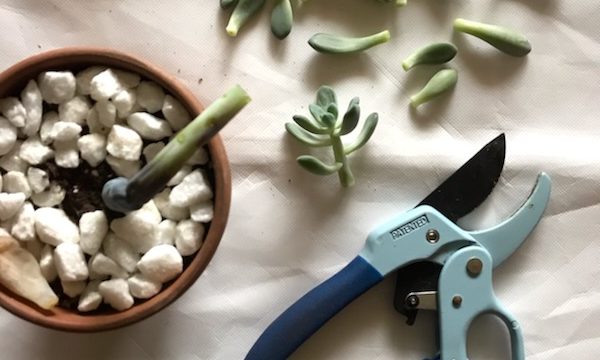
“Succulents are easy! Succulents are hard to kill! The perfect starter houseplant? – a succulent!”
So many lies. They’re not that easy, are the most common houseplant to suffer from overwatering and I would never give a succulent to a new plant parent. I love succulents of all types, especially since most of them are non toxic to cats and dogs, but someone needs to speak the truth.
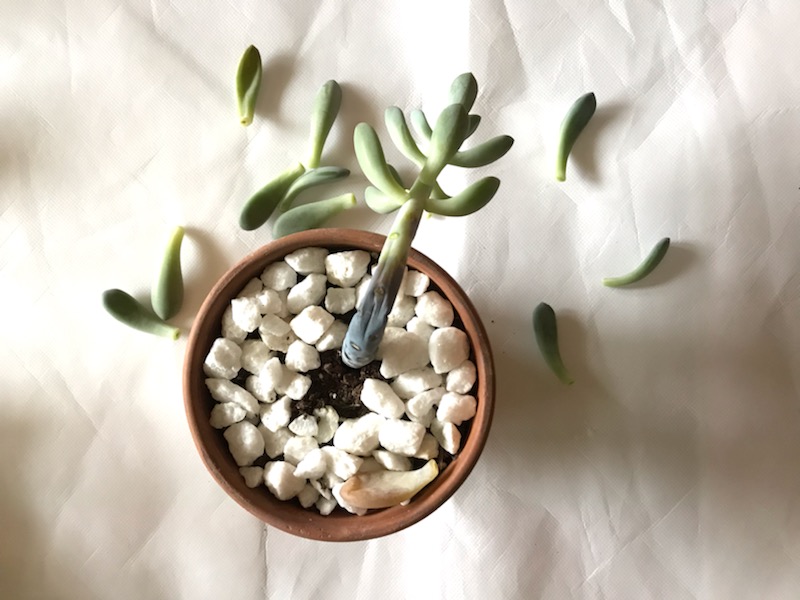
Up until fairly recently, I always had problems with succulents. I could never just get them right and never knew why. I usually experienced one of the following:
- Leggy stems – the plants grows but look leggy; the leaves become inches apart and the plant is obviously stretching. It then starts to shrivel and die a horrible death.
- Leaves that shrivel and fall off one by one. It then dies a horrible death.
- The plant gradually gets gross mushy stems and leaves and you don’t know why (see pic below). In a month it will die a slow horrible death.
- Yellowing leaves that still fall off one by one but the plant looks healthy. Don’t worry – it soon will die a horrible death.
Sad right? I thought so too, and wanted to end my cluelessness right there and then. I didn’t give into the notion that I have a black thumb and should give up. Yes, it is a bit discouraging if you can’t keep an EASY plant alive. But these aren’t easy and I didn’t give up and you shouldn’t either. Don’t give up. Don’t stop believing.
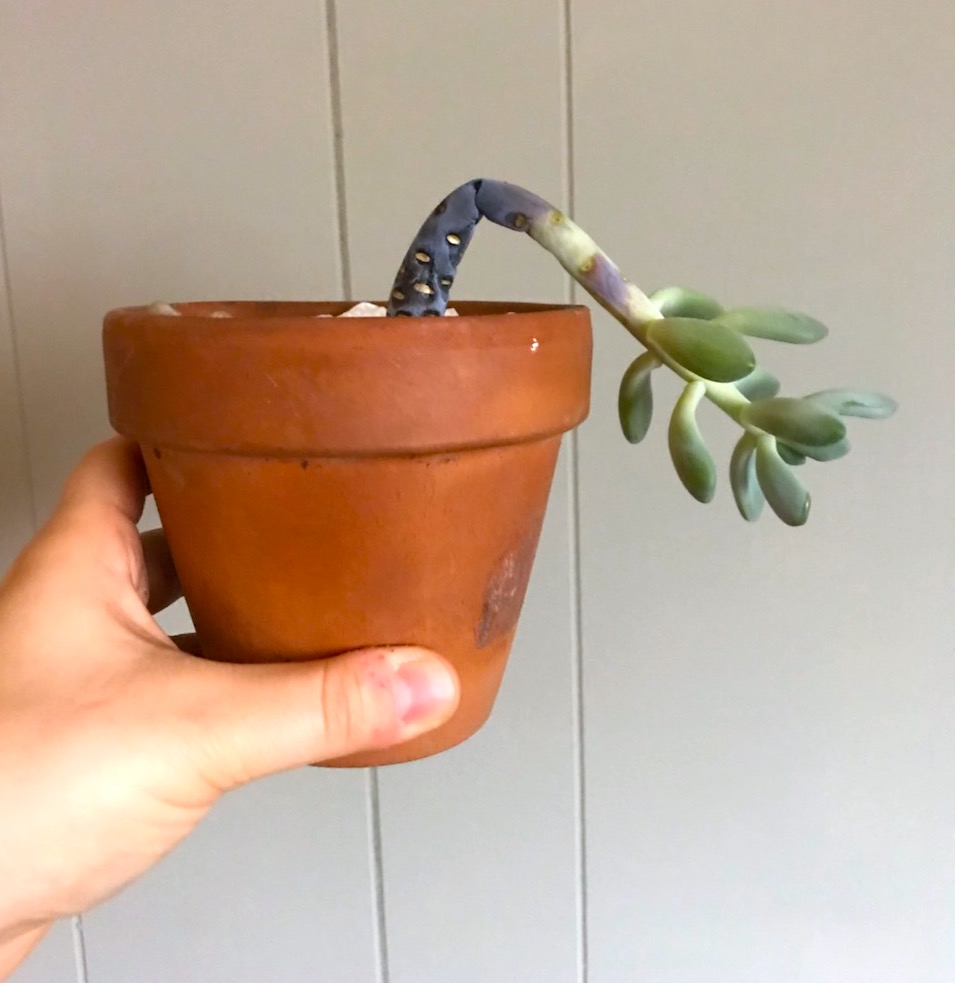
If your succulent has experienced one of the symptoms above, read on. It did take me some serious trial and error to have one live in my house comfortably, so all the work is done for you! Let’s learn the language of these lovely little plants together.
What are Succulents?
Succulents are fleshy little plants that typically live in arid climates and dry soil. Their muscular biceps (leaves) actually store water because they like these conditions. “Succulent” is actually derived from the Latin word sucus, meaning juice, or sap. Makes sense, right?
Which Succulent is Best for Indoors?
Many succulents do best outdoors and it’s very difficult to keep them happy in your home. There are a few pet safe options that don’t mind living under your roof at all such as:
Don’t have pets in your home? Then Jade, Aloe, String of Pearls, String of Dolphins, and Kalanchoe are also excellent easy to find options.
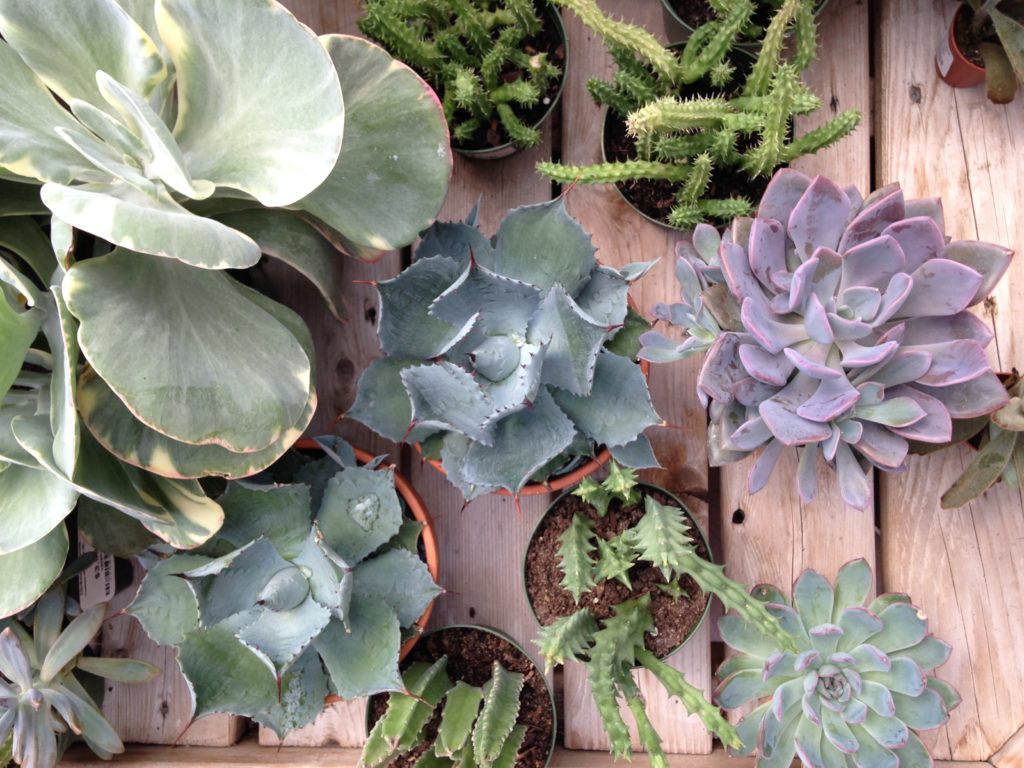
The Best Conditions for Succulents
The best place for succulents is bright and warm sunlight with no drafts or possibility of getting cold. This is very important, and may already offer insight on why your succulent is dying in your cold, air-conditioned office. They just don’t like that type of thing. Succulents need bright light a lot of the day, not air-conditioned or cold rooms.
Depending on where you live, you can leave succulents outdoors year round. Heck, most Southwest United States do. But if you’re like me and live in New York, which has four distinct seasons and temperature changes, that’s not an option. I leave succulents out in the sun all summer and early fall but bring them in as soon as temperature drops to 60 degrees at night.

When to Water
There is no rule as to how much one should water a succulent. One must simply know the signs. Watering on a schedule leads to overwatering, instead learning when and why a succulent needs water is much more beneficial for you and Planty. Basically, you are looking for a dried out plant. Succulents do not like to be moist, but to be 90% dry between waterings. I typically suggest purchasing a Moisture Meter until you become familiar with your plant’s needs.

Soil Matters
You can’t have succulents in any old garden soil. Moisture-hoarding potting mixes are a death sentence, making any bit of overwatering bad news. In the gardening section, you should notice a succulent mix, which is a mix of soil, sand, perlite, and small rocks. I actually add a cup or so more sand to the bag and give it a good shake. The extra sand always helps. Pot your succulent in this mix in a well draining pot (yes one with a hole) and you’re good to go.
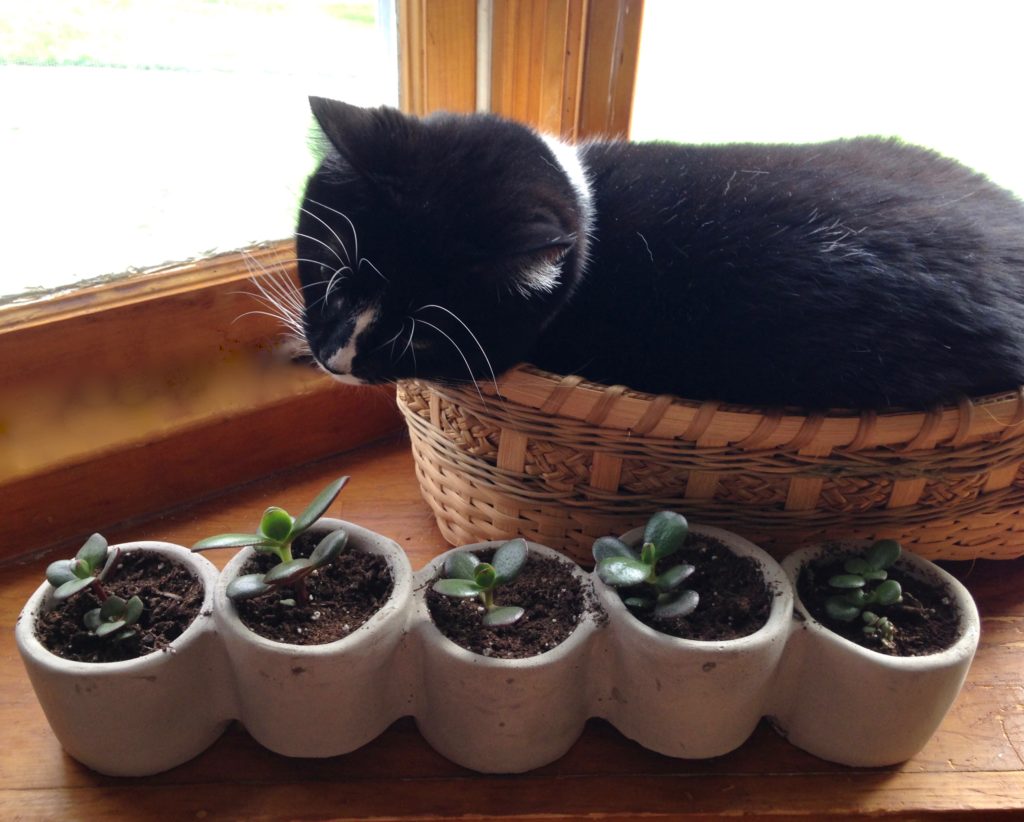
Where To Put Them So they Don’t Die
I’ll say it again – don’t put succulents in a cold, sunless office or room. In summer when the sun is hot I place them outside to soak it up fully and I think I’ve actually seen them dance with joy. I usually let rainwater take care of the watering, but do check them every day as the sun can make them toasty.
In cooler months, I crowd my succulents together on an IKEA cart (see below) indoors near a South-facing window. I don’t know what, but they do better inside in crowds.
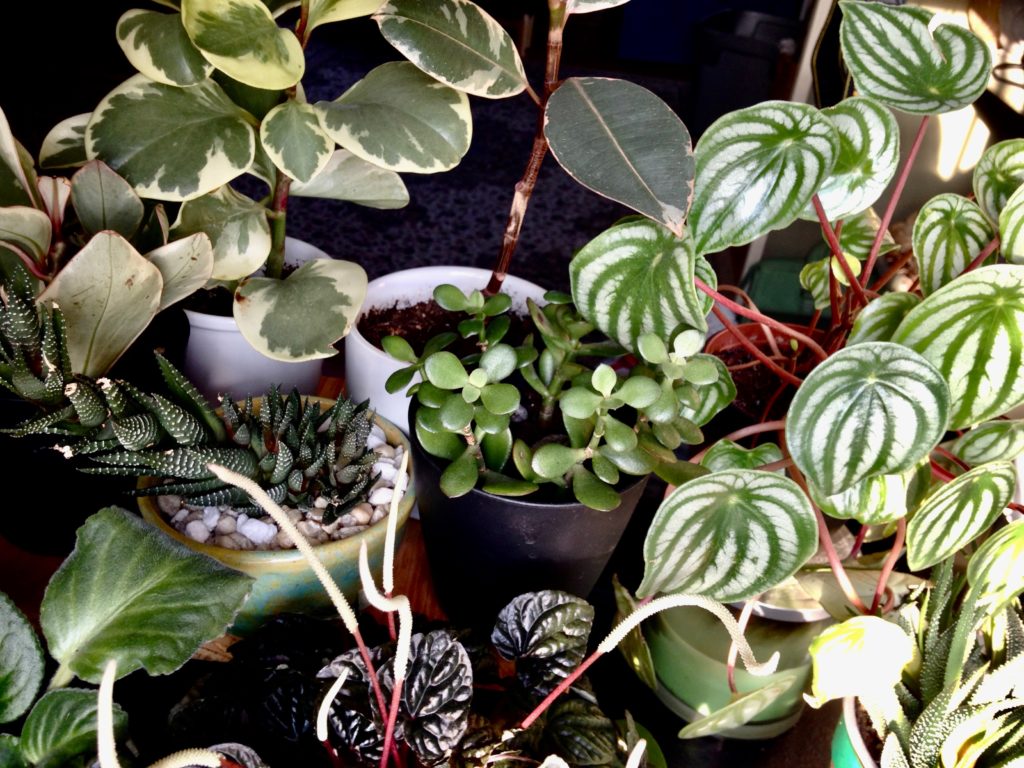
What About Leggy Plants?
Speaking of winter, succulents definitely stretch and become leggy when it’s a bit cooler. It’s usually because of lower light and lower temperatures. You might have noticed stretching before – it’s when the leaves become smaller and futher aprt on the stem. It looks like the plant is growing, but really it needs more light. Leaves should be small and compact like the assortment of succulents below.
What do I do? I chop their heads off. That’s right. Succulents are amazing growers and pruning them helps them stay pretty. I then plant the leaves and top from the cut piece in soil and make baby succulents.
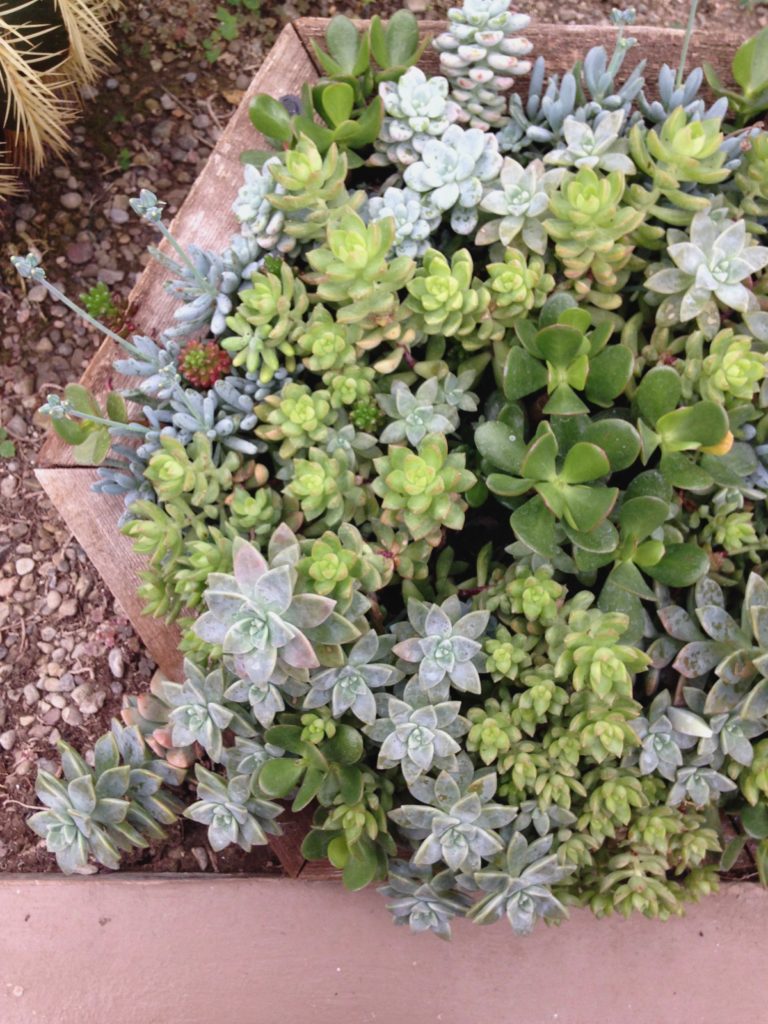
How to Propagate
My topics are leading into each other like a boss. After I’ve chopped my succulent’s head off, those leaves easily become new plants. How?
Follow these steps:
- First,
chop the top part of a succulent off. Don’t worry it will grow back even stronger.
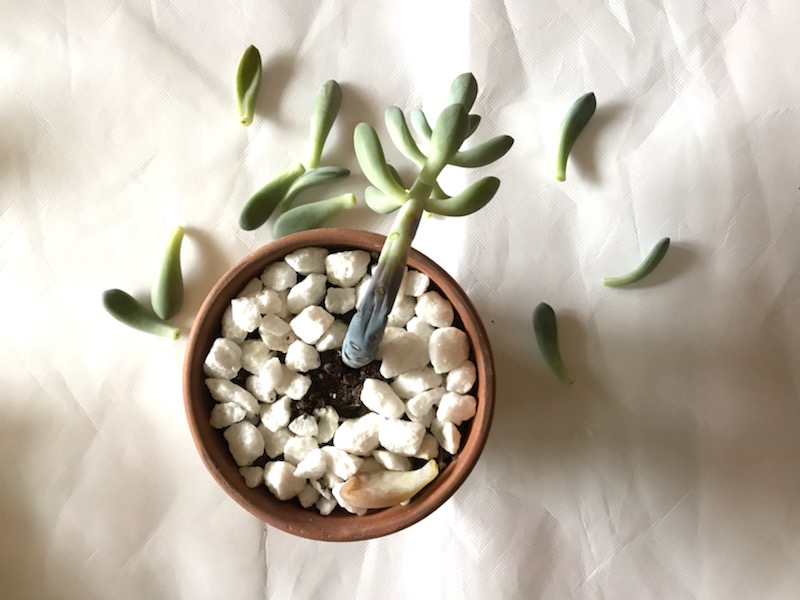
- Really,
don’t be scared, just cut it.
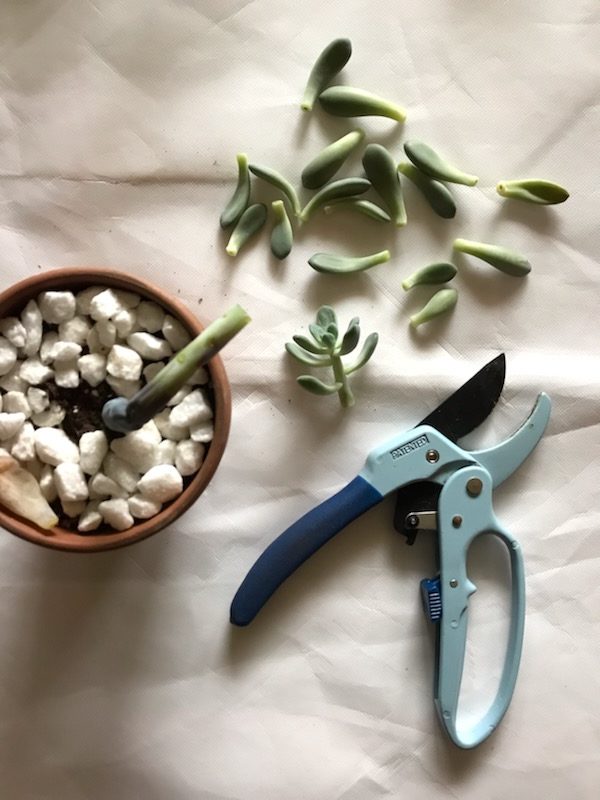
- And now…
that you’ve chopped, take off a bunch of those leaves on the stem and arrange them in a planter wit soil. Keep them resting right at the top. Give them a mist.
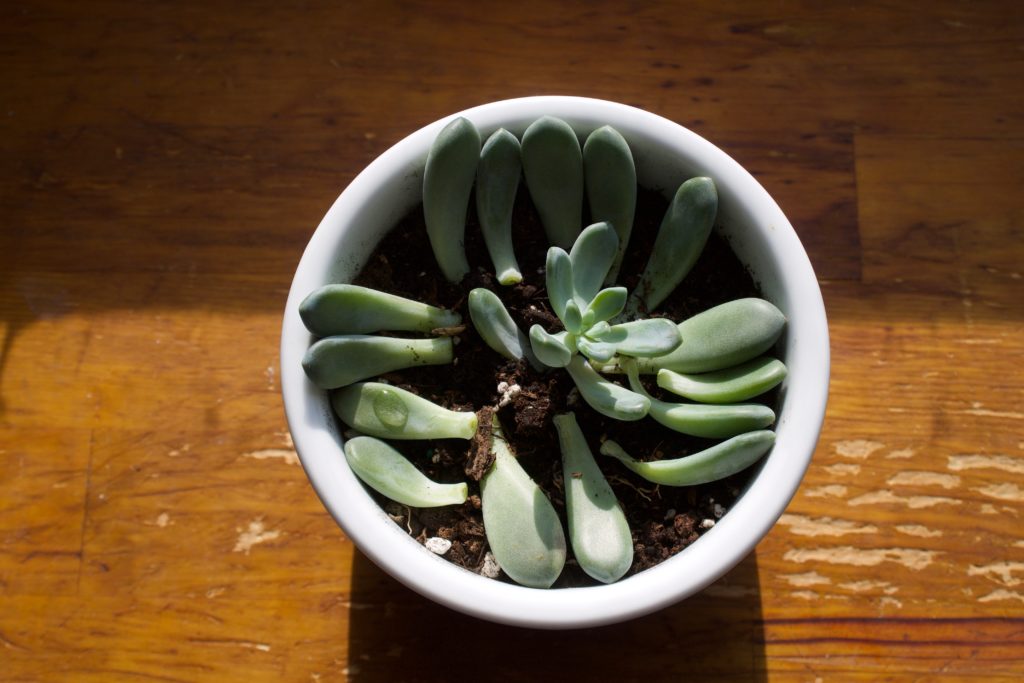
- Remember to…
keep the “head” of the plant intact and you can plant that right into a pot with soil. It will continue to grow and develop roots quicker than you think.
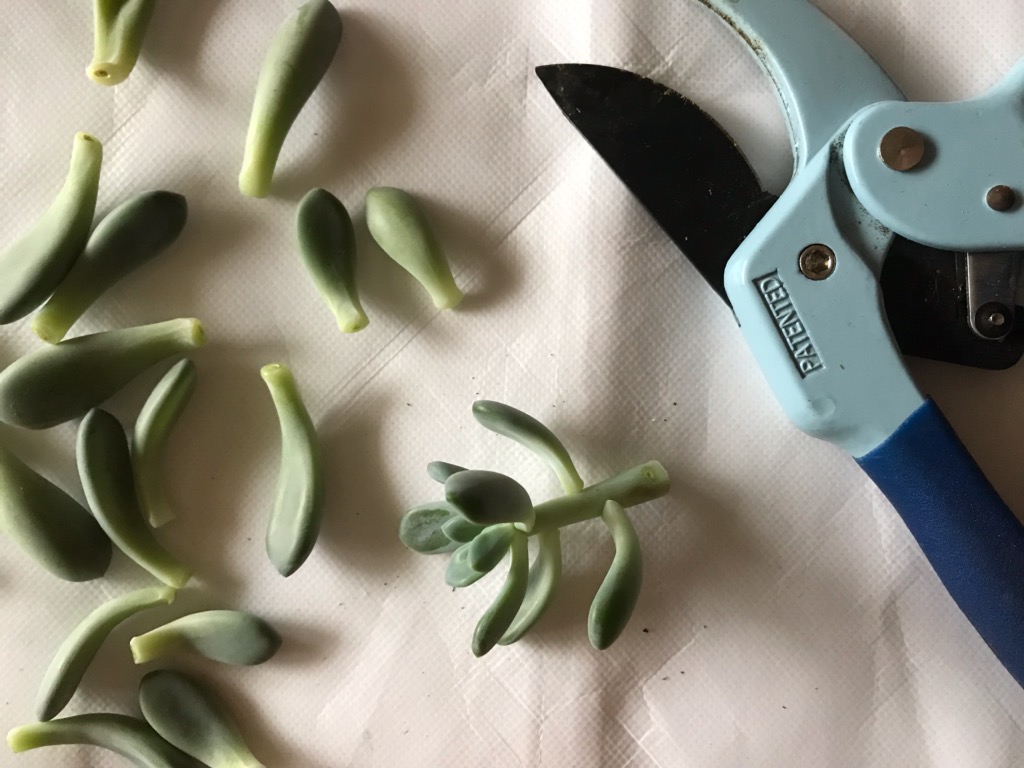
- And last,
mist the succulent babies every week or few days (more if it’s very warm out). You’ll see tiny leaves sprout soon! It takes about a month. These are from the same plant as above, fast forward a few weeks.
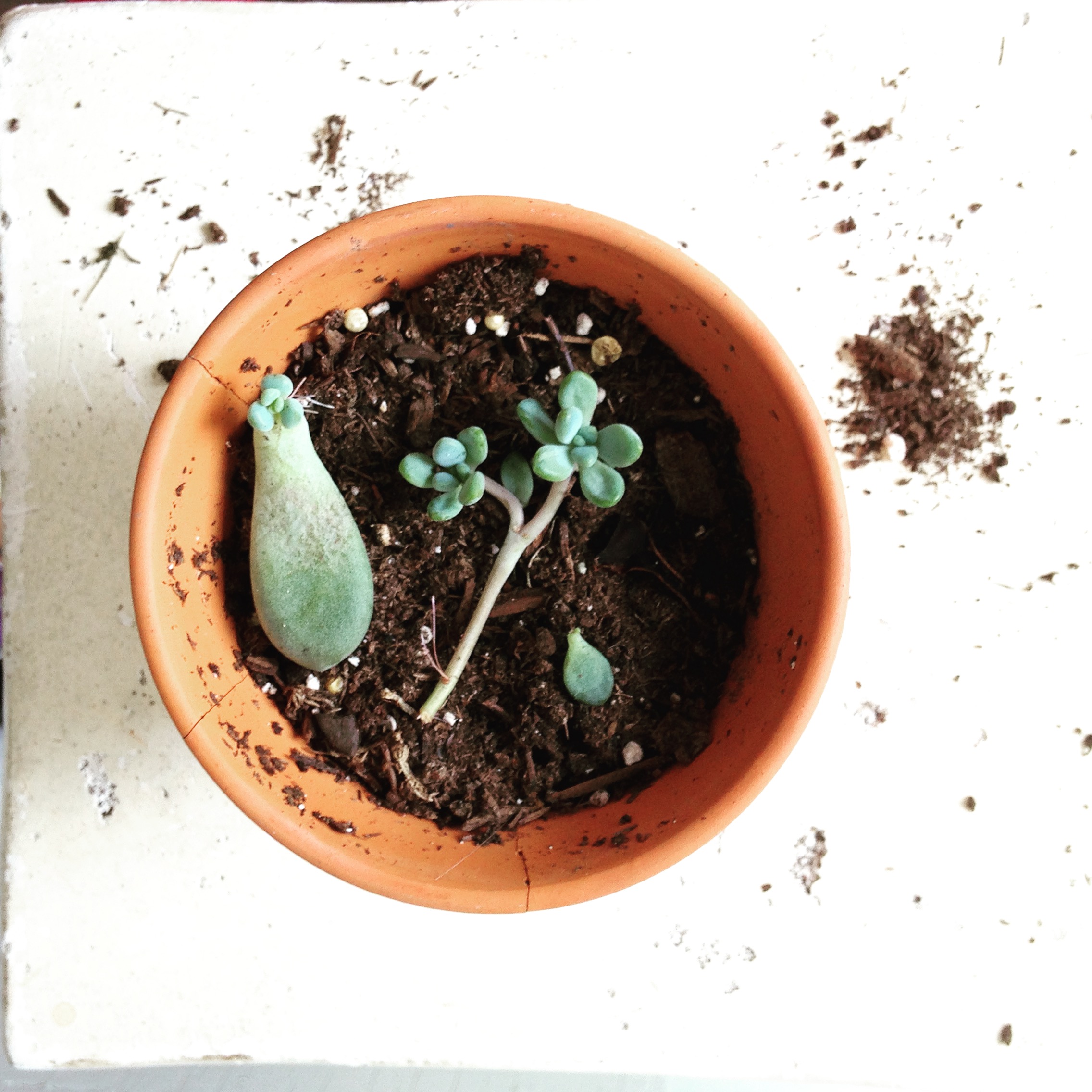
Still having issues with your succulents? Need more help? Leave a comment below!
*This post does contain affiliate links wherein Leaf and Paw may receive a small monetary fraction, which allows this blog to continue to create more and more things!

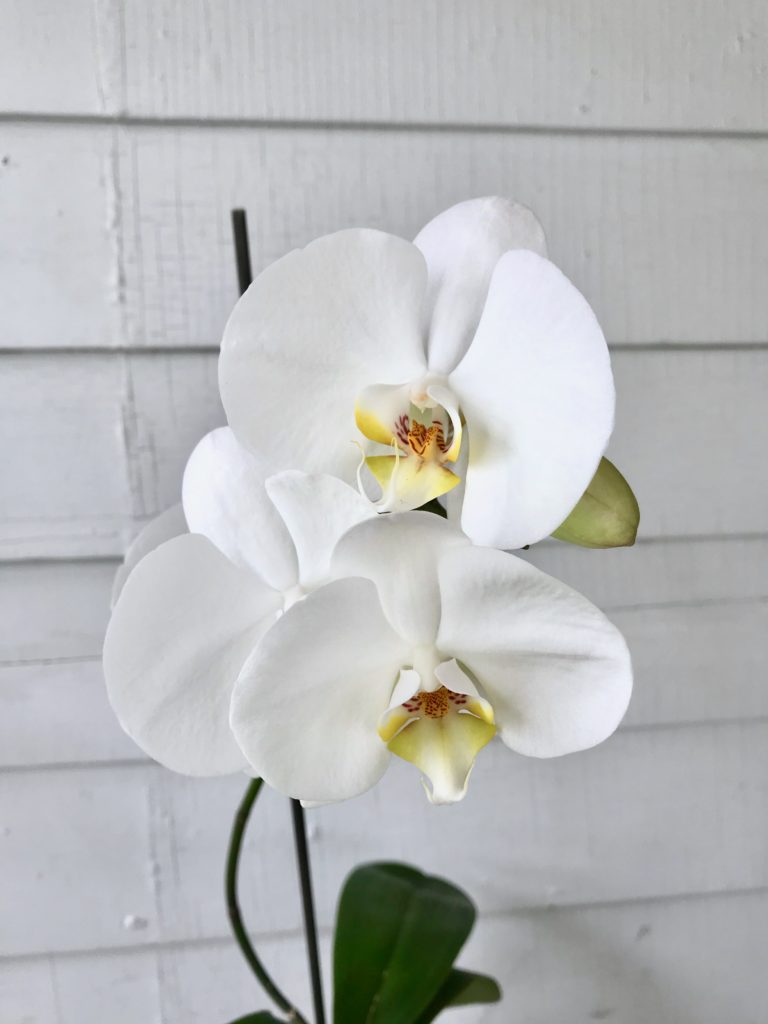
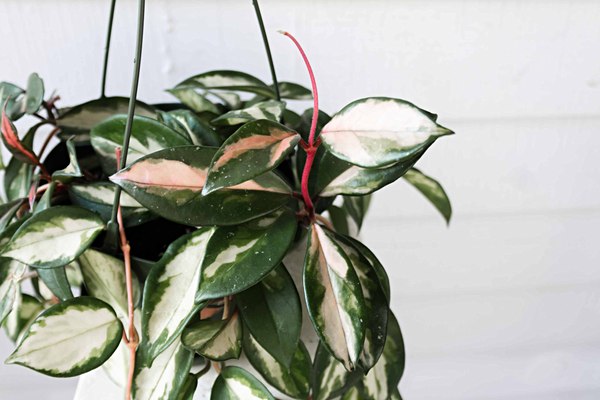
Oh boy! This post is so helpful! Now I know what was killing my babies ❄️??♀️ Thank you!!
Hi, my succulent (aloe tiki) leaves have all fell off and the bottom of each leaf is swelled up with water. Is there any chance of reviving them back?
I would stick them in soil and see what happens. It’s funny, sometimes succulent leaves don’t take root but some surprise you! It’s worth laying them on some soil to see what happens.
I have a Topsy Turvy plant that was seemingly healthy when I bought it, but after re-potting, I noticed some leaves develop dark bluish purplish spots that were wrinkly, and eventually the entire leaf would wrinkle and become less firm (but not necessarily all blue). Worried that the dark spots were a sign of rot, I delicately removed the leaves before they were able to spread to any other part of the plant, but every morning, I would notice more leaves beginning to wrinkle. It started at one side of the plant and is slowly making its way around, not from the bottom to the top like most plants wither. The stem is perfectly healthy and the leaves look healthy too (until they don’t) and I can’t find help anywhere on the internet. The leaves aren’t pale or yellow or mushy so I don’t think it’s a sign of overwatering, but usually rot has to do with water so I’m afraid to water them (even though some of the tips of the leaves are becoming dry and crisp). If you could help I would be so so grateful! How can I save the healthy parts of the plant?
Hi Krystal! This is an odd issue. I think I need some photos though. You can send them to me via facebook or email me (hello @ leaf and paw . com) and I’ll take a look. It actually sounds like the plant may be cold but it’s hard to say without seeing the damage.
Is fertiliser good for Succlent?
Hi Lisa, you can fertilize a succulent but use a high quality one (I like Jack’s), and cut the dose by half and only use once a month or so.
Hi! I have been having issues with all of my succulents recently, and no amount of research that I do has given me any answers. I am currently dealing with some succulents that have wrinkly/drying leaves towards the middle/top of the plant despite me watering the plant enough (I wait until the soil has dried). Additionally I am also dealing with succulents that seem to be turning mushy and seem overwatered, but I have had them for months and overwatering has never been an issue! I inspected the roots and no rot was present! I thought it was my planters, so I reported in terra cotta pots but nothing seems to be helping. Please help!! I don’t understand why none of my babies are thriving!
Hi Rachel! Oh dear. Some succulents are fussy and just die randomly but I think I know what the issue is. Wrinkly leaves means they are thirsty, so you may be waiting too long to water. Usually watering the plant thoroughly and letting all water drain out fixes this. The mushy stems could be a few things, too big of a planter (so there’s water sitting in the bottom), changes in temperatures (too cold), or most common, lack of light. All succulents love bright bright sun – ANYTHING less and the succumb to a sad death. I hope that helps and keep me posted!
I’m having the exact same problem as you! I’ve had about 20 different types of succulents for about 2 years. I live in Georgia where it’s really humid and hot during the summers so I keep them on my covered patio under some grow lights. During the last two weeks 10 of my echieveria have died. I know I’m not over watering, I wait more than 3 weeks sometimes between waterings just to be sure. But none the less, one by one has wrinkled and become mushy and died. I thought they were getting enough light from the grow lights but after reading this guys response I think that might actually be the culprit. I’m curious to how much light yours are getting and what climate you are in because our situation seems so similar.
Hey Kayleigh, that’s a lot of deaths, and it definitely sounds like not enough light. These guys can take A LOT of light, like more than I ever thought, and need it too. I only water them when they start getting a tad bit shriveled. It’s crazy hot in the summer (and humid) here in NY so I have mine outside in direct sun. I would take yours out from grow lights and place in a lightly shaded but bright area (so you don’t shock them). They should be a lot happier.
Hello! One of my Hens & Chicken succulent died up on the top (all the leaves became soft and shriveled) but the root still seems long and in tact with no sign of rot, what should I do and do you think it can be revived? Should I cut off the remaining top portion? I would be happy to send a picture if you need.
Hi Krys, Hmm. Honestly, H&C are pretty durable, so I would lop off the top that’s mush and it *should* grow some new growth from the top. If the stem is completely healthy (sometimes it’s deceiving) you should see new leaves in a few weeks, if not, the whole plant may end up turning to mush and won’t survive.
My baby is dying I only had it one month. I think I may have over watered. I did replant it yesterday then read online they need sun so put it outside now today it looks even worse. I think I stressed it out. What do you suggest . Also I was using tap water which is very hard on my skin so maybe it hurt my plant. For now on using distilled water. Can I send you a pic
Hi Leigha, You can send a pic to Facebook but I know you’ve definitely stressed it out. Hard water is something no houseplants enjoy (I recommend collecting rainwater as another alternative) and succulents do not always come back from overwatering. That + sudden direct sun made him very sad. I would cut any healthy part of the succulent off and stick it in new soil. Unless you see the whole main plant bouncing back at this point, it probably won’t make it, so propagating will give you a small healthy plant. And rememeber, succulents like to dry out competently before watering.
Hello.. my echeveria elegan’s root is rotting.. I’ve cut the top and directly stick it in the soil asap.. do u think it will survive?
It should. As long as the piece you salvaged was not rotting or mushy he should root just fine.
Hi! I bought jade plant and after a day of replanting it, leaves started to fall. I don’t know if I overwatered it because the leaves that fell doesn’t seem to be mushy. Then after two weeks, the stem turned black and seemed dry. What should I do?
Hi Kristel, I think it was overwatered. If you still have any leaves you can propagate the same why I explain here but the main plant is probably a goner. Jade really likes to dry out well, it will look a tad wrinkly when it’s time to water.
Hi I am new to succulents. I have recently purchased a Jade plant and all of my new growth has begun to dry, shrivel and die off. Any thoughts on what could be happening to my plant.
I have her in my sunroom which has 3 windows (1 South, 2 West), all of my windows are situated near the vent and the temperature in the room can max around 72F, she is planted in Miracle Gro cactus soil, I potted her up from a 2.5″ nursery pot into a 4″ painted ceramic pot with one drainage hole. Any help is greatly appreciated.
Hi Lawresa, so when a Jade plant gets wrinkly it can be over or underwatering. Without seeing it it sounds like it may be very dry and just very hot, but that pot is also much too big, so it may be overwatered. Unless she was pot bound (which they like to be) I would revert her back to the smaller pot. New leaves could be getting waterlogged. I would carefully monitor her watering for a couple weeks and only water when lower leaves are wrinkley and dry, Jade’s are very easily overwatered.
Hi Anastasia,
Your post lists String of Pearls, which I have been eyeing for over a year now, as a pet safe plant. Because I have a very curious cat, who likes to give almost every thing a good sniff, lick and a bite (or several), I tend to check if any plant I am planning to get is pet safe or not, and found that String of Pearls is not pet safe.
But now that I saw your post, would you please tell me if it is/how to make it safe for my furry nibbler?
You are correct Modhu – they are not safe technically. If you have a pet and want a SOP still, just keep it high on a shelf, or I recommend a hanging planter in a window wince they really like sun. As long as it’s away from reach you’ll be fine.